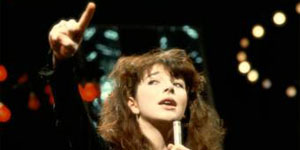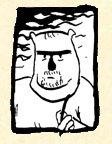The 100 Greatest Songs of the 1970s, Part III.

090. Led Zeppelin “When the Levee Breaks”
(Kansas Joe McCoy/Memphis Minnie)
Untitled, 1971
This is why Zeppelin matters. Their widescreen, Technicolor version of the blues in Surround Sound™ is one of the greatest achivements of rock & roll. Forget their development of the grammar of heavy metal, their stadium excess, their noodly hobbit crap, and the lowbrow “Zep rulz 4eva” culture that’s deified them at the expense of subtlety, intelligence and reason. The reason Bonham’s opening blows (“beats” doesn’t do them justice) have been so frequently sampled is that despite their lunkheaded reputation, Led Zeppelin is secretly funky underneath all that wail and roar. Seriously; I can’t listen to this song at work anymore, because I’ll look like an idiot bopping Cypress Hill-style to my headphones. It’s a truism that when white people try to play black, they usually pump up the volume, even though black music is generally notable for how much it holds back, how devious rather than blunt it is. (That’s what slavery and an underground-by-necessity culture will do.) With this song, Zeppelin lives up to the trusim and takes it the further step of making volume fundamentally necessary, a part of the artistic world of the song rather than just a racial signifier. This is Wagner to Memphis Minnie’s biergärtenlieder, a reconfiguring of everything we know to fit a new, more dangerous world. When the people refuse to listen to the dire prophecies contained in those crackly old 78s, maybe primal force will get their attention.
089. Chicago “Saturday in the Park”
(Robert Lamm)
Chicago V, 1972
Those opening reverbed piano notes are all I need. The rest of the song could just not exist, and I wouldn’t care, as long as that “dun-da-dun-na, dun-da-dun-na” was around for me to hear every once in a while. Okay, I guess the chicken-scratch guitar on the downbeat is pretty good to. And that first trombone note is wonderful. All right, fine, the rest of the song kicks ass. But it’s all about those piano notes. Chicago started out as a great band, a Miles Davis-influenced jazz-rock combo with side-long suites and funky prog-jazz hits like “25 or 6 to 4.” Then they recorded this song (although the rest of that album remained fiercely progressive), and they began their long slow slide into the maggot-infested easy-listening zombies that they became in the 80s. This song retains their old muscle, however, and is a breezy, truly delightful portrait of the kind of day that is usually shown in romantic comedies in montage form — frequently with this song playing over it. It’s almost the last echo of 60s optimism before the grim reality of the 70s set in, and although I could do without Lamm’s white-dude-singing-soul vocals (you can just tell he thinks he’s really cool just because he’s in a band and so gets laid a lot, even though he’s a dweeb), they end up being charming in some mysterious naïve-hippy fashion. Oh, and singing in Italian — always cool.
088. Nicky Hopkins “Speed On”
(Nicky Hopkins/Jerry Williams, Jr.)
The Tin Man Was a Dreamer, 1973
The ultimate session man (just about every decent rock & roll outfit between 1965 and 1980 had him lend a hand on the ivories now and again), Nicky Hopkins is also one of my favorite solo artists. Yes, he only recorded two LPs in the 70s, and only one of them wandered onto CD, but if he’d wanted to tour and do the usual pop-star thing, he could have been a less-smarmy Elton John or a less-pompous Billy Joel. But he was too shy, and too sickly, and preferred to just hang out with rock legends than be one. This song chronicles a bit of the tribulations of being a session man (another song on the album is called, even more directly, “ Waiting for the Band”), with him suffering an anxiety attack in the back seat of a cab because he’s late to the studio. It’s a fine, hard-driving song of the kind that would go extinct very soon, when velocity would become inextricably linked to volume. But here, George Harrison lends a hand on a perfect slide solo, there’s a drums-and-bongos breakdown, and Nicky screams and shrieks the lyrics into the mike like John Lennon at his most unhinged. The horn section that the Stones used on Exile makes a reappearance here (one of the perks of being a great session player is that you get to use other great session players on your solo work), and ultimately you’re left with the impression that the song is mostly about how amphetamines are a necessary part of the survival kit of a rock & roll musician.
087. Kate Bush “Wuthering Heights”
(Kate Bush)
single, 1978
I’m not gonna front: I prefer her 1986 re-recording of the song, in which she sounds marginally less like a Chipmunk singing to Dave Seville, but the fact remains that this is the definitive version, the song that brought her international fame at the age of 19, and which is still an amazing recording, twenty-eight years later. It’s based on the Emily Brönte novel, of course, and she sings from the point of view of rich young brat Katherine to her dark, murderous lover Heathcliff — though I’ve gotta wonder how many people think it’s about a cartoon cat — and she nails both the false high drama and florid emotion of the novel in her melody and arrangement. I read an article once that said that Kate Bush is like the weird, multi-necklaced art teacher we all had in high school who some people hated and others followed devotedly. That’s not a bad comparison, although she is of course a greater artist by a factor of thousands than anyone who’s still teaching high school — and she certainly projects enough of an eccentric-feminist vibe to creep out the jocks and inspire the sentimental goth chicks. Which isn’t really present in this song; Ian Bairnson’s Gilmourish solo provides enough muscle for the meatheads who can’t clue in to the fire behind her icy soprano and the joyous passion behind those marvelous piano runs. I do miss those cries on the fadeout, though.
086. The Pointer Sisters “Yes We Can Can”
(Allen Toussaint)
The Pointer Sisters, 1973
A decade before they became frizzy-haired dance-pop icons with “I’m So Excited,” the Pointer Sisters (Ruth, Anita, Bonnie and June) released two of the most wonderful albums of the 1970s, or, really, ever. The Pointer Sisters and That’s A-Plenty (1974) are an amazing showcase of a quartet that can do just about anything — and does. Veering from hard bop to Kansas City swing to psychedelic soul to bluesy funk to mile-a-minute vocalese to Tin Pan Alley to Broadway gospel to straight-up country — often, as the saying goes, within the space of a single song — they offer a too-brief lesson in the history of twentieth-century American music, and make a staggering case for the tragic underappreciatedness of the female vocal group along the way. The “sister act” is as old as vaudeville, but they transformed it into a new and compelling trans-genre form. Seriously, check them out. You’ll thank me later. This song, though, is more straightfoward. Allen Toussaint wrote it for Lee Dorsey in 1970, but these girls drive it home with a Sly & the Family Stone-derived groove, a San Franciscan stomp on a New Orleans shuffle, upping the feverish gospel quotient (Bonnie even proto-raps towards the end) and entering a kind of trance with their cut-glass harmonies on the infinitely-repeated chorus: a lesson that house music would later take to heart when it learned the value of synthesized loops and gospel samples. Just remember, they did it first.
Next: 085-081. >>

No comments:
Post a Comment